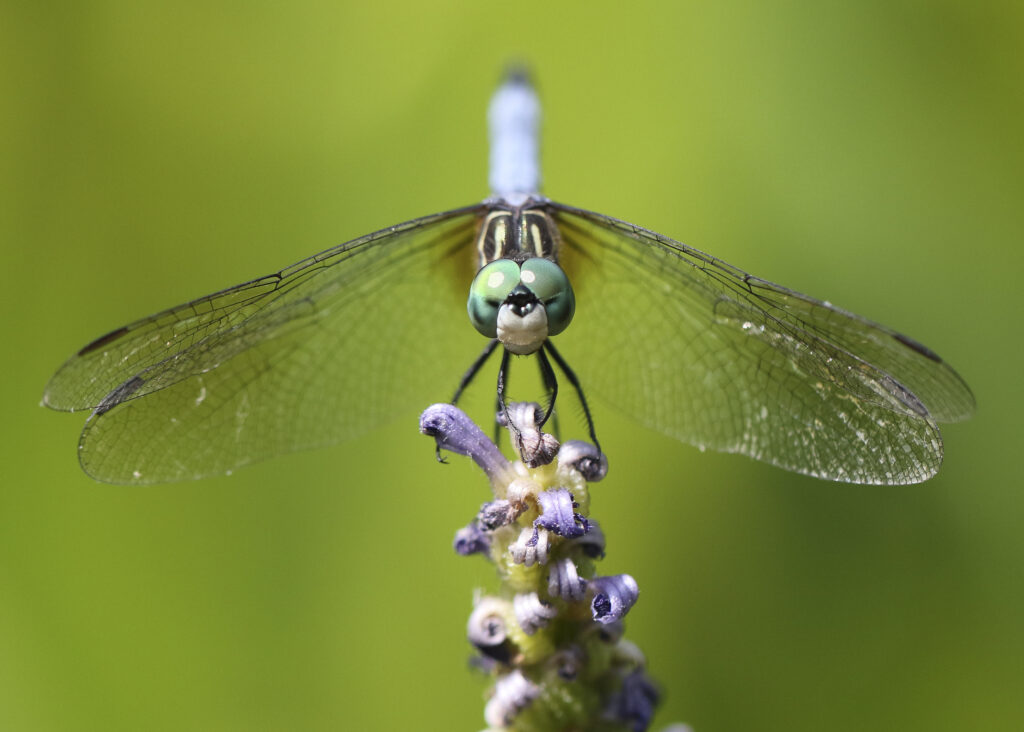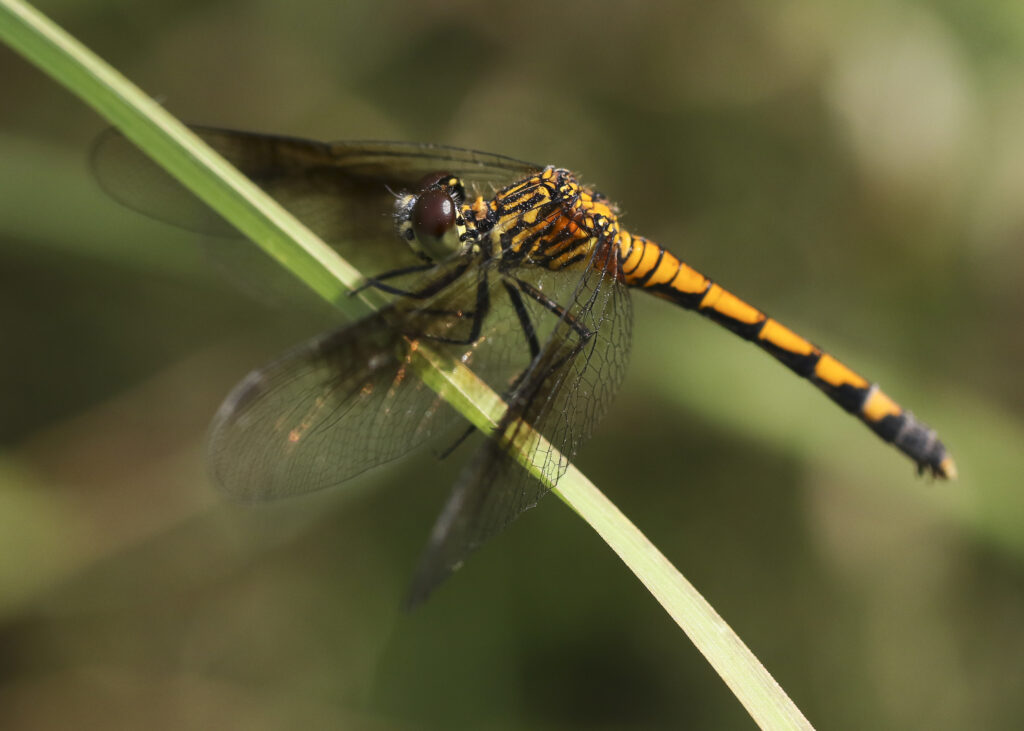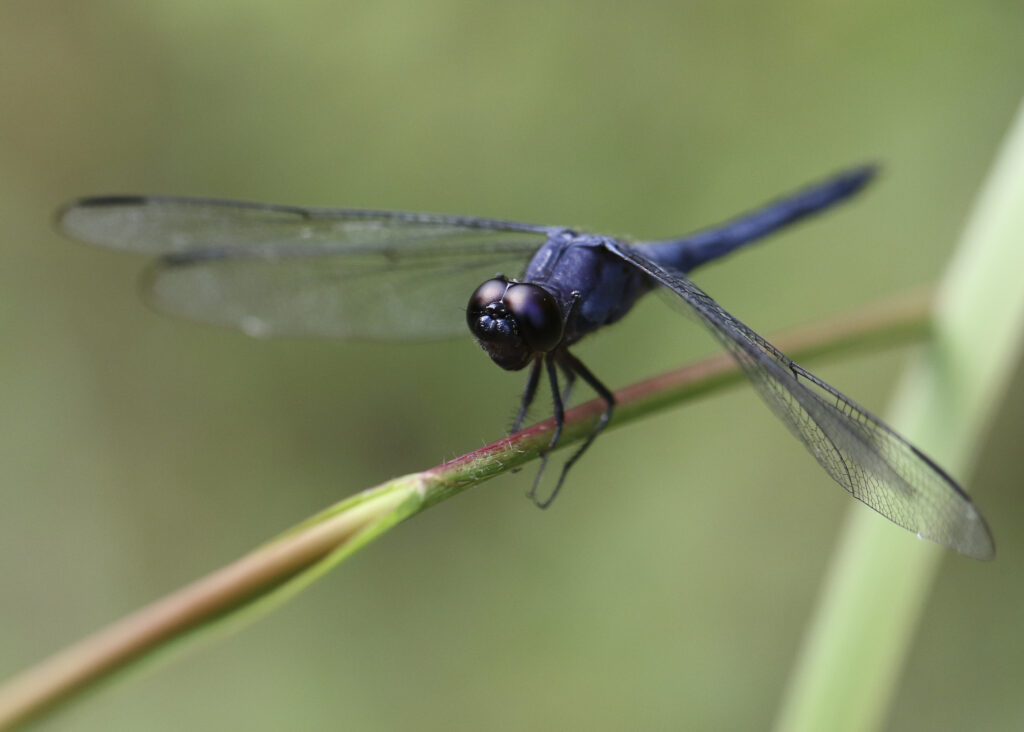Photo Tips for Shooting Insects

By Wayne Bierbaum
This week I was walking one of the trails at Jug Bay Wetlands Sanctuary in Lothian when a horsefly began buzzing me. It was super annoying. The darn bug would hit my ear, fly at my eyes, land on my neck or just circle my head. It wouldn’t go away. Finally, it landed on my left ear and as I was shaking my head to dislodge it, a large dragonfly flew right at me and suddenly turned to my left. I heard the rattle of the dragonfly’s wing and a crunching sound. My excellent new friend, the dragonfly, carried off that pesky horsefly. But darn if the dragonfly landed too high in a bush for me to get a good photograph.
I decided to go somewhere with lots of dragonflies and try to get some photos. Chesapeake Bay Environmental Center (CBEC) in Grasonville is essentially an island (at high tide) surrounded by marsh grasses and is loaded with marsh flies, mosquitoes, and dragonflies.
There are several freshwater ponds there that support developing dragonfly nymphs. I was lucky to be there the same week that several dragonfly species were starting to leave their watery lives as nymphs and emerge as flying mosquito eaters. Of the 129 species of dragonflies listed in the Maryland Biodiversity Project, I got photos of eight different species.
The most colorful one I saw was the autumn meadowhawk. The males are bright red and tend to spend a lot of time perched about waist height, an easy photo-op. Another colorful dragonfly was the very tiny seaside dragonlet. The female is golden in color and the males are almost black. The dragonlet is the only Western Hemisphere dragonfly whose nymph lives in saltwater. They are a saltmarsh dragonfly that typically emerges in late summer. Unfortunately, they tend to perch below knee-high—which is hard on an old photographer’s back.

When shooting photos of insects it’s important to understand some biology. Dragonflies are very motion sensitive. Perched dragonflies are difficult to walk up on. To get a photo, I have to move extremely slowly and avoid any sudden movement. This includes movement of a camera strap, a foot, a finger—anything.
If I hold very still, then, to a dragonfly, I become part of the scenery and not a predator. They basically stop being able to see you.
Patience is needed because the dragonfly may suddenly chase a bug or be challenged by another dragonfly. If it does fly, I wait while holding still because they frequently will return to the same resting spot.

There are three elements that I pay attention to when taking any animal’s photo. The first is to get a good focus on the closest eye. The second is finding a pleasant non-distracting background. Last is using the proper exposure of the subject.
After I shift my position to get a decent background, I adjust my camera settings. I like a blurred background, so I set the aperture to be fairly wide open, f/3.2 to f/5, which gives a very narrow focus depth of field.
For insects, I use a macro lens but any lens that allows the bug to fill one-quarter of the frame would be good. I use spot focusing and move the “spot” to cover the closest eye. I then adjust the exposure value according to the background. Using center-weighted light metering, if the background is dark compared to the subject then I increase the shutter speed to prevent overexposure of the dragonfly. Then if the background is bright compared to a dark subject then I decrease the shutter speed to bring out the dark insect.

To get really close, I will slowly extend my arm away from my face but toward the insect. I still look through the viewfinder and keep the focus spot on the animal’s eye.
One of the hardest photos to capture is one where the eyes, back of the thorax, wings, and abdomen are all in focus and still have a narrow depth of field. Putting all the body elements in the same focal plane is very difficult as the dragonfly is frequently adjusting itself—which makes me adjust my position (slowly) and right when I am about to press the shutter the dragonfly moves again.
Of the 50 photos I got at CBEC, only one, an autumn meadowhawk, had all the elements on the same focal plane.
Of course there are certain species of dragonflies, like darners and saddlebags, that rarely perch. The approach to those hovering insects is to use a telephoto lens with a high shutter speed and more narrow aperture and trying to catch one hovering in place.
I use the same approach for photographing butterflies but since they have a great sense of smell they must be approached from downwind. Butterflies also move continuously while feeding on flowers, which makes for a lot of wasted shots. I frequently will post myself near the best-looking flower and wait for one to fly in.
I like getting an eye and tongue in focus along with part of a wing so I frequently use a smaller aperture of f/7.1 or f/8. Many butterflies will open their wings fully once or twice right after landing. It happens quickly so to get all parts of the wing in focus the shot has to be fast and from the right height. When there is no wind, the butterflies will leave their wings open longer. A windless day is best for butterfly shots.
When taking photos of amphibians and reptiles, I basically use the same approach: move slowly and extend my arm and camera away from my face. That extension blocks them from seeing my eyes which makes them feel less threatened.
Jug Bay Wetlands Sanctuary has a butterfly garden and a large number of butterflies and dragonflies zipping around. Fort Smallwood Park, Sandy Point Park and CBEC have diverse wetlands that support a wide variety of dragonflies including the seaside dragonlet.
If you want a challenge, head out and see how many species you can capture in a photo. But if the book Dragonflies and Damselflies of the East by Dennis Paulson is any indication of the size of this challenge, it’s could be a lifelong task. The book is 538 pages long.
